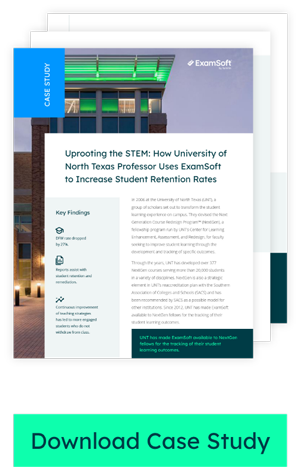Using SLO assessment to drastically decrease drop, fail, and withdraw (DFW) rates
Background
In 2006 at the University of North Texas (UNT), a group of scholars set out to transform the student learning experience on campus. They devised the Next Generation Course Redesign Program™ (NextGen), a fellowship program run by UNT’s Center for Learning Enhancement, Assessment, and Redesign, for faculty seeking to improve student learning through the development and tracking of specific outcomes.
Through the years, UNT has developed over 377 NextGen courses serving more than 20,000 students in a variety of disciplines. NextGen is also a strategic element in UNT’s reaccreditation plan with the Southern Association of Colleges and Schools (SACS) and has been recommended by SACS as a possible model for other institutions. Since 2012, UNT has made ExamSoft available to NextGen fellows for the tracking of their student learning outcomes.
The Problem
UNT Assistant Professor of Chemistry Dr. Rob Petros performs research on pharmaceuticals that target specific and problematic areas of affected cells. He also teaches a lower-division, large enrollment course in organic chemistry. He became increasingly aware of national data indicating that only 40% of entering college students who declare STEM majors complete degrees in STEM disciplines, as his own courses were reflective of these trends. In Fall 2009, his course drop fail withdraw (DFW) rate hovered around 34% (with 108 students), but by Fall 2012 the rate grew to 41% (with 145 students).
The Solution
To improve his teaching methods, keep his students successfully engaged, and keep more students enrolled in his organic chemistry course, Dr. Petros applied for a NextGen fellowship and set out to improve the learning and engagement levels. First, he flipped his course, moving away from the traditional PowerPoint-and-lecture style and toward engaged-learning activities. He created 252 podcasts covering the entire year of subject material for his course.
He also began using ExamSoft to “tag” his student learning assessment items to learning outcomes, course objectives, and instructional strategies. Now, after each exam, Dr. Petros gives his students personalized learning outcomes reports from ExamSoft that highlight their strengths and indicate opportunities for improvement.
With the NextGen model and ExamSoft, Dr. Petros is also able to identify (and redesign) areas where student attainment is low on a course level, and then make up for any attainment gaps with targeted remediation strategies. For example, a recent class only scored a 56% average on an exam. After finding what areas needed more improvement in the ExamSoft reports, Dr. Petros provided students with targeted remediation covering the outcomes with the biggest disparity in attainment. A subsequent assessment of students’ attainment of those learning outcomes, after the provided remediation, indicated that the initial 56% average jumped to 71%. Finally, after giving his students the ACS Standardized Final Exam in Spring 2014, 42% of his students performed above the national average.
With newly implemented assessment strategies for his course, which enable real-time quality improvement strategies, Dr. Petros has seen increased student engagement which has been reflected in a significant decrease inDFW rates. During the Spring 2014 semester, a full academic year after he implemented ExamSoft, Dr. Petros’ DFW rate dropped to only 10%—a 27% difference from the previous year
Key Benefits
- DFW rate dropped by 27%
- Reports assist with student retention and remediation
- Continuous improvement of teaching strategies has led to more engaged students who do not withdraw from class
“The major benefit of utilizing ExamSoft in my course redesign has been the framework it provides to collect significant amounts of actionable student attainment data that would otherwise be impractical to collect. With this data, I am able to easily identify and modify assessment items and instructional strategies in need of refinement, which has resulted in demonstrable improvements in student engagement and performance,” said Dr. Petros.
The Case for ExamSoft
- ExamSoft is the leader in outcomes-attainment assessment technologies. With ExamSoft, schools and faculty can immediately begin incorporating innovative ideas into their programs—all they need to do is change their way of thinking and consider how outcomes-based assessment can be a part of the process.
- ExamSoft clients have seen student retention rates increase and have retained up to $2.2 million in student tuition revenue every year. Can you afford not to implement?







